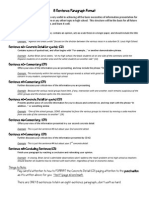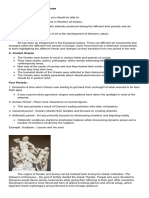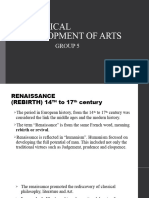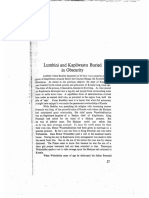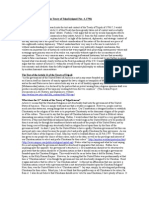0 ratings0% found this document useful (0 votes)
68 viewsUNIT 2 - Western ARt
UNIT 2 - Western ARt
Uploaded by
Carl ZornosaThis document provides an overview of key art movements and styles from prehistoric times through contemporary art. It begins with Stone Age and pre-historic arts, then outlines major periods and styles such as Egyptian arts, Renaissance art, Baroque/Rococo, Romanticism, Impressionism, Cubism, Futurism, and concludes with definitions of modern and contemporary art. The goal is for students to understand how art has evolved over time and the historical and cultural influences behind different movements.
Copyright:
© All Rights Reserved
Available Formats
Download as PDF, TXT or read online from Scribd
UNIT 2 - Western ARt
UNIT 2 - Western ARt
Uploaded by
Carl Zornosa0 ratings0% found this document useful (0 votes)
68 views64 pagesThis document provides an overview of key art movements and styles from prehistoric times through contemporary art. It begins with Stone Age and pre-historic arts, then outlines major periods and styles such as Egyptian arts, Renaissance art, Baroque/Rococo, Romanticism, Impressionism, Cubism, Futurism, and concludes with definitions of modern and contemporary art. The goal is for students to understand how art has evolved over time and the historical and cultural influences behind different movements.
Copyright
© © All Rights Reserved
Available Formats
PDF, TXT or read online from Scribd
Share this document
Did you find this document useful?
Is this content inappropriate?
This document provides an overview of key art movements and styles from prehistoric times through contemporary art. It begins with Stone Age and pre-historic arts, then outlines major periods and styles such as Egyptian arts, Renaissance art, Baroque/Rococo, Romanticism, Impressionism, Cubism, Futurism, and concludes with definitions of modern and contemporary art. The goal is for students to understand how art has evolved over time and the historical and cultural influences behind different movements.
Copyright:
© All Rights Reserved
Available Formats
Download as PDF, TXT or read online from Scribd
Download as pdf or txt
0 ratings0% found this document useful (0 votes)
68 views64 pagesUNIT 2 - Western ARt
UNIT 2 - Western ARt
Uploaded by
Carl ZornosaThis document provides an overview of key art movements and styles from prehistoric times through contemporary art. It begins with Stone Age and pre-historic arts, then outlines major periods and styles such as Egyptian arts, Renaissance art, Baroque/Rococo, Romanticism, Impressionism, Cubism, Futurism, and concludes with definitions of modern and contemporary art. The goal is for students to understand how art has evolved over time and the historical and cultural influences behind different movements.
Copyright:
© All Rights Reserved
Available Formats
Download as PDF, TXT or read online from Scribd
Download as pdf or txt
You are on page 1of 64
Find your best art buddy and describe the following
briefly in a yellow paper.
1.Stone Age 11.Mannerism arts
2.Pre-historic Arts 12.Baroque and
3.Paleolithic arts Rococo arts
4.Neolithic arts 13.Neoclassicism 19.Cubism
5.Egyptian arts 14.Romanticism 20.Futurism
6.Geometric arts 21.Minimalism
15.Realism
7.Archaic art
16.Impressionism 22.Expressionism
8.Classical art
17.Art Nouveau 23.Pop Art
9.Hellenistic art
10.Renaissance art 18.Fauvism
by: Maam Jannet C.Broas
By the end of this lesson, the students should be able to:
1. Discuss how art was used by prehistoric people to
depict everyday life;
2. Discuss the importance of their chosen art to the history
and development of art and
3. Explain the relevance of their artwork to the chosen
topic
4. Discuss the brief background of the original
painter/creator
LESSON 7:
ART IN EARLY
CIVILIZATIONS
•Stone Age is a term used to
describe a period of history
when stones were used to
make tools for survival.
•The unearthing of
archeological artifacts and
remains provides modern
society a glimpse of the
beliefs, practices, and
activities of early civilizations.
•Archeological explorations
reveal that there has been
a gradual shift from a
nomadic lifestyle of early
humans to that of
permanent settlements,
paving the way for the rise
of early civilizations.
1. Paleolithic Art is a
product of climate
change.
Artworks can be
considered ornamental but
there is little evidence to
fully back up this notion,
that early humans created
these cave paintings for
that very purpose.
2. Neolithic art has
developed especially
when life for the early
humans has become
more stable.
Egyptian Art:
•The Egyptian civilization
can be divided into three
periods: Old, Middle, and
New Kingdoms.
•Looking at the three
periods, it can be noticed
that for the Egyptians, art
should be something
religious and spiritual.
Egyptian Art:
•During the Old Kingdom, it was
evident that religion was bound to
the afterlife.
•One of the key features of the
Middle Kingdom is a shift in the
political hierarchy. There is an
emergence of powerful groups of
landlords that threatened the
authority and rule of the pharaoh.
Egyptian Art:
•Because of the internal
struggle between these two
influential sides, art has taken
a back seat during the
Middle Kingdom. In order for
art to reemerge and flourish,
Egypt needed to have a
more stable situation.
LESSON 8:
ART OF EMERGING
EUROPE
The development of Greek art can
be divided into four periods:
1. Geometric
2. Archaic
3. Classical
4. Hellenistic
1. The Geometric Period was
when geometric shapes and
patterns have taken the
spotlight in most of the artworks.
2. The Archaic Period placed
importance on human figures.
This was primarily a result of
Greece’s trading activities with
other civilizations.
3. The Classical Period - The peak
of Greek sculpture and
architecture
4. The Hellenistic Period - The time
of Alexander the Great. During
this time, art was primarily
focused on showcasing
emotions and depicting reality.
Ancient Rome:
•The Romans were
fond of the Greeks
and their
achievements in the
arts.
• The fusion of Greek
and Roman cultures
can be seen in most
Roman artworks.
Middle Ages:
•Since the Church
was the most
important figure, the
most important
products of the early
Middle Ages would
have to be copies of
the Christian
scriptures.
Renaissance Art:
•During the Renaissance Period, artists valued the
“individual” as a subject of arts. The influence of
humanism shifted the focus of some artworks during
the Renaissance Period to empower the “individual.”
Most artworks emphasized naturalism, which was also
an influence of humanism since there was a great
emphasis on the proportionality of the human body.
Mannerism:
•Mannerism was a period in art
history, which was a product of
the Renaissance Period. During
the Renaissance, artists would
observe nature and try their best
to emulate it based on their
observations
•It is named after maniera, an
Italian term for “style” or
“manner,” and refers to a
stylized, exaggerated approach
to painting and sculpture.
Baroque and Rococo:
•The term “baroque” is
derived from the Portuguese
term barocco which is
translated as “irregularly
shaped pearl.” This is a
suitable description that
Rome was the birthplace of
the Baroque Period, which
according to some historians
was a response to
Protestantism.
Neoclassicism:
•Neoclassicism was a
movement in Europe that
transpired during the late
18th and early 19th centuries.
It was the dominant art
movement that time which
basically aimed to revive
and rekindle the influences
of Greek and Roman into art
and architecture.
Romanticism:
•Romanticism, as an art
movement, used the
central themes of
Neoclassicist artworks as a
springboard. Romanticists
have highlighted heroic
elements into their work.
•Strongly emphasis on
emotion and individualism
Romanticism:
•characterized by a
heightened interest in
nature, emphasis on the
individual's expression of
emotion and
imagination, departure
from the attitudes and
forms of classicism, and
rebellion against
established social rules .
Realism:
•Realism as a style of work
focuses on the accuracy of
details that depicts and
somehow mirrors reality.
•Realism as a modern
movement in art veered
away from traditional forms
of art.
Impressionism:
•The Impressionism movement
started in France, which led to a
break from the tradition in
European painting.
•Impressionism is a style of
painting that emerged in the
mid- to late 1800s.
•Impressionist artists incorporated
scientific principles to achieve a
more distinct representation of
color.
Post-Impressionism:
•It is an art movement that
emerged in France, which is a
result of both the influence and
rejection of Impressionism.
Neo-Impressionism:
•As an art movement, neo-
impressionism is considered
as a response to empirical
realism of impressionism.
•Most painters who subscribe
to such movement rely on a
systematic and scientific
techniques that have a
predetermined visual
effects not only on the
artwork itself but also how
the audience perceive the
art.
Art Nouveau:
•Between 1890 and 1910,
countries from Europe and the
United States witnessed the
emergence and flourishing of a
new art style.
•This ornamental style of art was a
break from the conservative
historicism, which was the
prevailing and dominant theme
of most Western artworks.
Fauvism:
•This is a style of painting
that emerged in France
around the turn of the
20th century.
• they used pure and
vibrant colors by
applying straight from the
paint tubes directly to the
canvas.
•which is characterized
by strong colors and
fierce brushwork.
Cubism:
•Between 1907 and 1914, French
artists Pablo Picasso and Georges
Braque introduced a new visual arts
style called cubism.
•Cubists highlighted the two-
dimensional surface of the picture
plane.
•the style is characterized by
fragmented subject matter
deconstructed in such a way that it
can be viewed from multiple angles
simultaneously.
Futurism:
•It is an early 20th century art
movement that started in Italy,
which highlighted the speed,
energy, dynamism, and power of
machines.
•common themes for works in this
movement are restlessness and the
fast-pace of modern life.
•an Italian art movement that
defined modernity as motion, speed
and dynamism.
LESSON 9:
CAUGHT IN BETWEEN:
MODERN AND
CONTEMPORARY ART
Defining Contemporary:
•The complexity of defining the term is attributed to the
fact that people have dissenting views on the
interpretation of the “present,” of “today,” or what the
“now” means— these are often ideas that follow the
word contemporary.
•Even more so, is when it is hinged on the word “art”
and suddenly it becomes a bit fuzzy.
•Means “the art of today,”
• Another source of confusion is the fact that in the
colloquial, “modern” and “contemporary” are
considered synonymous.
•Modern art saw the digression of artists away from past
conventions and traditions and toward freedom. There
is the famous adage of “anything goes.” With the
world becoming increasingly complex, it required an
art that could accommodate such range and
breadth.
Contemporary Art:
•Contemporary art was heavily driven
by ideas and theories, and even the
blurring of notions of what is and can
be considered as “art”.
•Reeling after the war, one of the early
movements was abstract expressionism
(early 1940s to mid-1960s) which took
the basic tenets of abstraction and
combined with it with gestural
techniques, mark-making, and a
rugged spontaneity in its visual
articulation.
Contemporary Art:
•Creating energy was at the
center of "op art" or optical
art (early 1960s onward),
which relied on creating an
illusion to inform the
experience of the artwork
using color, pattern, and
other perspective tricks that
artists had on their sleeves.
Contemporary Art:
•The quest for actual movement in
the works created were
responded to by kinetic art (early
1950s onward). Harnessing the
current and direction of the wind,
components of the artwork which
was predominantly sculptural,
most were mobiles and even
motor-driven machines, was an
example of how art and
technology can be brought
together.
ANG KIUKOK (FILIPINO, 1931-2005)
Contemporary Art:
•But perhaps the most pertinent
movement that solidified the
move to contemporary art was
postmodernism. By the very
name, it was a nudge to
formalize the critique toward
modernism and its claim over art
for the better of the 20th century.
9 CONTEMPORARY
ART STYLES AND THEIR
CHARACTERISTICS
1. Abstract Art
oAbstract art originates from unnatural
objects, such as geometric patterns,
shapes, and formats.
oThis type of art is based on landscapes
and figures and depicts simplicity,
spirituality, and purity.
oAbstract art is all about colors, lines,
textures, patterns, compositions, and
processes.
o This is why abstract art is known as
nonobjective art or concrete art that
usually embraces non-representational
work.
2. Figurative Art
oFigurative art describes modern art
that genuinely depicts the real-world
issue by using the human figure.
oThis art type's ultimate goal is to
provide a realistic representation of
life by using illusionary characteristics.
o In the contemporary art world, this
art style can also be used with other
art types such as minimalist, cubist,
and abstract art to create
masterpieces
3. Geometric Art
o geometric art represents different
shapes, angles, lines, points, and
elements, totally inspired by geometry.
o This contemporary art style uses a
wide array of geometric shapes, such
as circle, square, triangle, and
rectangles to make complex shapes
and objects.
oGeometric art designs come in
different types, sizes, and shapes.
4. Minimalist Art
o Minimalism is a type of abstract art that
uses different geometric shapes, such
as square, rectangle.
oThe main idea behind using this type of
art is used to depict reality without any
imitation.
o It represents different aspects of the
real world, such as landscapes, persons,
experiences, emotions, and feelings.
o Minimalist artwork depicts a highly
purified form of beauty, simplicity, truth,
and harmony.
Minimalism
cropped up in the early
1960s in New York, and saw
artists testing the boundaries
of various media. It was seen
as an extreme type of
abstraction that favored
geometric shapes, color
fields, and the use of objects
and materials that had an
“industrial” sparse.
5. Still Life Art
o Still-Life art is one of the essential types
of Western art that represents still life
paintings and dead sculptures.
oThis type of artwork includes nearly all
types of human-made or natural
objects, such as fruits, vegetables,
food, games, and other inanimate
objects.
oIn contemporary art, still life art is used
to depict the celebration of material
pleasures and remind viewers about
the brevity of human life.
6. Typography
o Typography is a contemporary art style
that uses existing and modern typefaces
to arrange text and appropriately
convey the message—basically,
typeface design letters of alphabets that
express specific techniques, feelings, and
brand identity.
oTypography art is one of the most
important aspects of the contemporary
art design used in the print and web
design industry.
7. Pop Art
o Pop art is one of the most famous artistic
developments that emerged in reaction to
commercial cultures, mass media, and
consumerism.
o artists use commonplace objects,
newspapers, comic strips, bottle cans,
road signs, and other popular commercial
world items to convey their message.
o Artists are allowed to incorporate names,
logo designs, and images of celebrities
into their artwork. Artists have complete
freedom to take inspiration from any
source or object.
•Pop art first emerged in the
1950s but found its footing in
the 1960s. It drew inspiration,
sources, and even materials
from commercial culture,
making it one of the most
identifiable and relatable
movements in art history.
8. Surrealist Art
o Surrealism is an artistic and philosophical
movement that was flourished in Europe
between World War I and II.
oThe principles,ideals or practice of
producing fantastic imagery or effects in
an art
oSurrealist art mainly focuses on exploring
irrational and subconscious notions.
o Surrealist artists enjoy experimenting with
different languages and objects to
convey their internalized thoughts.
Surrealist art usually portrays incredible
graphics and proactive imagery.
9. Sculpture Art
o Sculpture art is a three-dimensional art
made by four basic processes: carving,
modeling, casting, and constructing.
oCarving is a sculptural technique that uses
different tools to create a shape by cutting
a solid material such as wood or stone.
oIn the process of casting, artists have to
make a mold and then pour a liquid
material. In the modeling phase, artists build-
up shapes by using soft material, such as
clay or wax.
oThe last step of constructing and assembling
involves bending, folding, stitching, welding,
weaving, and other techniques to build
sculptures.
Photorealism:
•The resurgence of figurative
art, where realistic depictions is
a choice, is a proof how varied
and fragmented
postmodernism is.
•In photorealism, a painstaking
attention to detail is aimed,
without asserting an artist’s
personal style.
Conceptualism:
As opposed to celebrating
commodities as references to
real life, conceptualism fought
against the idea that art is a
commodity.
is art in which the concept(s) or
idea(s) involved in the work take
precedence over traditional
aesthetic, technical, and
material concerns.
Thank you for listening
You might also like
- Art - Appreciation - Unit - 2 For StudentsDocument37 pagesArt - Appreciation - Unit - 2 For StudentsJomar Catacutan100% (1)
- Arts of Emerging EuropeDocument25 pagesArts of Emerging EuropeHannah Gajardo82% (22)
- Life Skills Unit 2Document11 pagesLife Skills Unit 2Morning-Star AnwarNo ratings yet
- 8 Sentence Paragraph FormatDocument1 page8 Sentence Paragraph Formatfareedh_meeranNo ratings yet
- UNIT 2: Western Art HistoryDocument42 pagesUNIT 2: Western Art HistoryKenneth Rodriguez Herminado100% (1)
- Art Appreciation Lesson 8Document17 pagesArt Appreciation Lesson 8Mavis Vermillion100% (6)
- Western Art HistoryDocument25 pagesWestern Art HistoryMary Charlin Bendaña100% (1)
- Western Art HistoryDocument5 pagesWestern Art HistoryDessiren De GuzmanNo ratings yet
- Art Appreciation - Lesson 8Document22 pagesArt Appreciation - Lesson 8louiejustinagarin21No ratings yet
- Art App ReviewerDocument9 pagesArt App Reviewervalderamarose2No ratings yet
- Summary of Lesson 8Document7 pagesSummary of Lesson 8Mildred AnnNo ratings yet
- Art of EmergingDocument4 pagesArt of EmergingpendatunaloyodanNo ratings yet
- Lesson 8Document44 pagesLesson 8Mary Mae ArnadoNo ratings yet
- Art Emerging EuropeDocument50 pagesArt Emerging EuropeGwen Mark CrespoNo ratings yet
- Art of Emerging EuropeDocument24 pagesArt of Emerging EuropeRochiel AmparadoNo ratings yet
- art-app-finalsDocument8 pagesart-app-finalsLowelyn PresidenteNo ratings yet
- LESSON 8. Art of Emerging EuropeDocument2 pagesLESSON 8. Art of Emerging EuropeFraulein Von EboñaNo ratings yet
- Summary of Lesson 8Document5 pagesSummary of Lesson 8Mildred AnnNo ratings yet
- Arts Lesson2Document5 pagesArts Lesson2Ira OrenciaNo ratings yet
- Ancient Greece SIR MARLOUDocument8 pagesAncient Greece SIR MARLOUKemverly CapuyanNo ratings yet
- Art of Emerging EuropeDocument56 pagesArt of Emerging EuropeKhelly Joshua UyNo ratings yet
- Concepts of ArtDocument57 pagesConcepts of ArtKristel Calcetas LlarenaNo ratings yet
- Active and Passive Voice Video TranscriptDocument3 pagesActive and Passive Voice Video Transcriptjaylouisedale.badaNo ratings yet
- Art AppsDocument99 pagesArt AppsLanch Chester CatubayNo ratings yet
- Lesson-8-Art of Emerging EuropeDocument16 pagesLesson-8-Art of Emerging EuropeRuby Jane Durado100% (1)
- Chapter 10 Various Arts MovementsDocument11 pagesChapter 10 Various Arts MovementsestifhaniejeshorapaNo ratings yet
- Development of Visual Arts in Western - PaintingDocument18 pagesDevelopment of Visual Arts in Western - PaintingMharc LindoNo ratings yet
- AH4 4th Week Lesson 3 READING VIUAL ARTSDocument7 pagesAH4 4th Week Lesson 3 READING VIUAL ARTSdermha LuigiNo ratings yet
- Art of Emerging Europe ReportDocument73 pagesArt of Emerging Europe ReportMicaela Baculod100% (6)
- Art Appreciation-Western ArtDocument27 pagesArt Appreciation-Western ArttheyuhhNo ratings yet
- Saint Ferdinand College: "Art Appreciation"Document4 pagesSaint Ferdinand College: "Art Appreciation"Kryza CastilloNo ratings yet
- Lesson 8 Art of Emerging Europe: Ancient GreeceDocument7 pagesLesson 8 Art of Emerging Europe: Ancient GreeceJeff JoverNo ratings yet
- The Greatest Civilization in The History of Ancient Art, Was The First Culture To Adopt A Recognizable Style of Art.Document4 pagesThe Greatest Civilization in The History of Ancient Art, Was The First Culture To Adopt A Recognizable Style of Art.Rheamar Angel MolinaNo ratings yet
- Module 7-WPS OfficeDocument4 pagesModule 7-WPS OfficeKim ChíNo ratings yet
- Art App MidtermDocument7 pagesArt App MidtermlorraineemillysanjoseacadsNo ratings yet
- Paper 1 Rafam SabsabiDocument3 pagesPaper 1 Rafam Sabsabisw99r8hgphNo ratings yet
- Notes. European Art HistoryDocument2 pagesNotes. European Art HistoryhazelmariedmNo ratings yet
- Art of Emerging Europe 1B GR7Document48 pagesArt of Emerging Europe 1B GR7Rosan Yanise100% (4)
- The RenaissanceDocument52 pagesThe RenaissanceSuyai BressánNo ratings yet
- Development of Visual Arts in Western - PaintingDocument18 pagesDevelopment of Visual Arts in Western - PaintingMharc LindoNo ratings yet
- Group 2 Art of Emerging EuropeDocument24 pagesGroup 2 Art of Emerging EuropeIsrael DonnabelNo ratings yet
- HUM101Document10 pagesHUM101Kharrel YballeNo ratings yet
- Lesson 1: The Eras of Art and Music ObjectivesDocument8 pagesLesson 1: The Eras of Art and Music ObjectivesSheená EspañolNo ratings yet
- Art Movements & Styles TimelineDocument34 pagesArt Movements & Styles Timelinedjyo2002.doNo ratings yet
- Lesson 1: Art and Its ConventionsDocument11 pagesLesson 1: Art and Its ConventionsCherry Jara100% (1)
- Estrella-Art AppreciationDocument14 pagesEstrella-Art AppreciationChristine joy NgatoNo ratings yet
- Renaissance To FuturismDocument3 pagesRenaissance To FuturismKristine PangahinNo ratings yet
- Art AppDocument9 pagesArt Appelizabeth bernalesNo ratings yet
- Historical Development of ArtsDocument43 pagesHistorical Development of ArtsEdrian jay TiburcioNo ratings yet
- CONTEMPORARY ARTS NgayonDocument20 pagesCONTEMPORARY ARTS NgayonJane Irish MendozaNo ratings yet
- Name: Llapitan, Abegail V. Section: Bped-1A Gec 5 Topic 6 Activity 1Document4 pagesName: Llapitan, Abegail V. Section: Bped-1A Gec 5 Topic 6 Activity 1Christine LlapitanNo ratings yet
- Neo ClassicismDocument8 pagesNeo Classicismdeborahkayode465No ratings yet
- Major Stylistics PeriodDocument4 pagesMajor Stylistics PeriodClydeNo ratings yet
- Art TimelineDocument5 pagesArt TimelineLPM AcousticNo ratings yet
- Finals Gen Ed 6Document23 pagesFinals Gen Ed 6Reymark PagalingNo ratings yet
- NeoklasicizamDocument11 pagesNeoklasicizamMilicaBožićMarojevićNo ratings yet
- 01 Art History MovementsDocument5 pages01 Art History MovementsRowin MarquezNo ratings yet
- Art Appreciation: Group 8Document5 pagesArt Appreciation: Group 8Nico JoaquinNo ratings yet
- Navajo HealingDocument21 pagesNavajo Healingsy734No ratings yet
- hw410 U1 ExerciseDocument5 pageshw410 U1 Exerciseapi-241287985No ratings yet
- Bonnie Berry - Social Rage - Emotion and Cultural Conflict (Garland Reference Library of Social Science) (1999) PDFDocument295 pagesBonnie Berry - Social Rage - Emotion and Cultural Conflict (Garland Reference Library of Social Science) (1999) PDFajayNo ratings yet
- TLPDocument10 pagesTLPBeng KalawNo ratings yet
- Oral Communication in Context Week 3, Quarter 1, S.Y. 2021-2022 Answer SheetDocument2 pagesOral Communication in Context Week 3, Quarter 1, S.Y. 2021-2022 Answer SheetDiana GorospeNo ratings yet
- The Future of AdvertisingDocument6 pagesThe Future of Advertisingapi-25886768No ratings yet
- Oral Expression Assessment CriteriaDocument2 pagesOral Expression Assessment CriteriaNoé Raúl García SaldivarNo ratings yet
- Ns 30 - Mini Lesson - Treaty RightsDocument3 pagesNs 30 - Mini Lesson - Treaty Rightsapi-310123009No ratings yet
- Allen WeiDocument6 pagesAllen Weiapi-207065960No ratings yet
- Meaning of GroupDocument6 pagesMeaning of Grouprosana f.rodriguezNo ratings yet
- Lumbini and Kapilavastu Buried in Obscurity: The Islamic ConnectionDocument6 pagesLumbini and Kapilavastu Buried in Obscurity: The Islamic Connectiondharma nextNo ratings yet
- School ID Division District VII School Name Sum-Ag National Hs School Year 2016-2017 10 Section AchieversDocument18 pagesSchool ID Division District VII School Name Sum-Ag National Hs School Year 2016-2017 10 Section AchieversAce HocateNo ratings yet
- Mytha Isabel D. Sales: Educational BackgroundDocument2 pagesMytha Isabel D. Sales: Educational BackgroundMytha Isabel SalesNo ratings yet
- Could Fulfillment Ever Be Felt As Deeply As Loss - A PostcoloniDocument56 pagesCould Fulfillment Ever Be Felt As Deeply As Loss - A PostcoloniNOORULFALEELANo ratings yet
- Straight Talk Foundation Annual Report, 2008Document44 pagesStraight Talk Foundation Annual Report, 2008Straight Talk FoundationNo ratings yet
- Thoughts On Article 11 of The Treaty of Tripoli (Signed Nov. 4, 1796)Document7 pagesThoughts On Article 11 of The Treaty of Tripoli (Signed Nov. 4, 1796)api-26363838No ratings yet
- Abu Rayhan Al Biruni Manuscripts in UzbekistanDocument152 pagesAbu Rayhan Al Biruni Manuscripts in UzbekistanAbul Hasan100% (2)
- Elu545-Unit lp3 1Document11 pagesElu545-Unit lp3 1api-457396206No ratings yet
- Music Definition Objectives History PDFDocument30 pagesMusic Definition Objectives History PDFEscarez Rustia MahinhinNo ratings yet
- The Ottoman Coinage of Tilimsan / Michael L. BatesDocument15 pagesThe Ottoman Coinage of Tilimsan / Michael L. BatesDigital Library Numis (DLN)100% (1)
- Peranakan Chinese and BabaDocument9 pagesPeranakan Chinese and BabaKamaleshwar Naidu Nadarajan100% (1)
- Corporatesocialresponsibility 180922141347Document16 pagesCorporatesocialresponsibility 180922141347Roden MansuetoNo ratings yet
- Cross-Cultural Marketing Strategies in The Context of GlobalizationDocument17 pagesCross-Cultural Marketing Strategies in The Context of GlobalizationYBA LEMONNo ratings yet
- Elementary Laboratory School Department: A Detailed Lesson Plan in Arts Iii I. ObjectivesDocument19 pagesElementary Laboratory School Department: A Detailed Lesson Plan in Arts Iii I. ObjectivesMaira SagunNo ratings yet
- Gcse Spa Support 5225Document75 pagesGcse Spa Support 5225Erika ToNo ratings yet
- Paper Composition of Screening Test For SST PostsDocument1 pagePaper Composition of Screening Test For SST PostsMuhammad IdreesNo ratings yet
- Let's Learn Mandarin!!: Andarin OurseDocument17 pagesLet's Learn Mandarin!!: Andarin OurseAn AceNo ratings yet
- Boyd, Winesburg, Ohio - IntroductionDocument7 pagesBoyd, Winesburg, Ohio - IntroductionTR119No ratings yet




